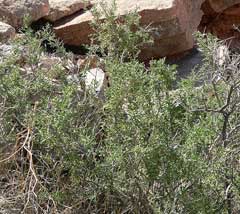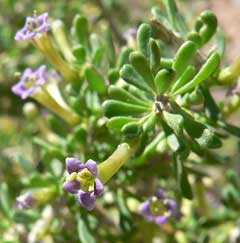 |
|
http://commons.wikimedia.org/wiki/User:Stan_Shebs |
 |
| http://commons.wikimedia.org/wiki/User:Stan_Shebs |
Translate this page:
Summary
Lycium species,
Boxthorns have adapted to hot, dry conditions and drought tolerance and are often found in dry, desert-like environments. Goji (L. barbarum) has ripe, nutrient-rich berries eaten raw or cooked and has a mild, sweet liquorice flavour. Young shoots are cooked and used mainly as a flavouring or lightly cooked as a vegetable, with a flavour similar to cress or peppermint. Chinese Boxthorn (L. chinense) has similar uses to Goji. With a sweet, aniseed-like flavour, ripe fruit is eaten raw, cooked in soups or dried for later use. African Boxthorn (L. ferocissimum) berries, leaves, stems and roots are toxic to humans. They are highly resilient to heat and drought and are used as hedges or ornamental plants. It is invasive in some regions. European Boxthorn (L. europaeum) grows in rocky and sandy soils, thriving in drought conditions. They are grown for hedging and erosion control. It has edible berries eaten ripe. Desert Thorn's (L. andersonii) native range is from New Mexico to the NW. Mexico, where it grows in desert or dry shrubland. The berries are edible, but other species are preferred. It is used in xeriscaping and for erosion control in dry landscapes.
Harvesting: Late summer to early autumn when the berries are fully ripe and have turned bright red.
Physical Characteristics
![]()
![]() Lycium andersonii is a deciduous Shrub at a medium rate. The species is hermaphrodite (has both male and female organs) and is pollinated by Bees. The plant is self-fertile.
Lycium andersonii is a deciduous Shrub at a medium rate. The species is hermaphrodite (has both male and female organs) and is pollinated by Bees. The plant is self-fertile.
It is noted for attracting wildlife.
Suitable for: light (sandy), medium (loamy) and heavy (clay) soils, prefers well-drained soil and can grow in nutritionally poor soil. Suitable pH: mildly acid, neutral and basic (mildly alkaline) soils. It cannot grow in the shade. It prefers dry or moist soil. The plant can tolerate maritime exposure.
UK Hardiness Map
US Hardiness Map
Synonyms
Plant Habitats
Woodland Garden Sunny Edge;
Edible Uses
Edible Parts: Fruit
Edible Uses:
Fruit - raw or cooked[61, 177]. It can also be dried and used whole as a flavouring in soups or ground into a powder and used as a mush or mixed with cereal flours[161, 257]. Only the fully ripe fruits should be eaten[K].
References More on Edible Uses
Medicinal Uses
Plants For A Future can not take any responsibility for any adverse effects from the use of plants. Always seek advice from a professional before using a plant medicinally.
Cancer
The fruit of many members of this genus is a very rich source of vitamins and minerals, especially in vitamins A, C and E, flavanoids and other bio-active compounds. It is also a fairly good source of essential fatty acids, which is fairly unusual for a fruit. It is being investigated as a food that is capable of reducing the incidence of cancer and also as a means of halting or reversing the growth of cancers[214].
References More on Medicinal Uses
The Bookshop: Edible Plant Books
Our Latest books on Perennial Plants For Food Forests and Permaculture Gardens in paperback or digital formats.

Edible Tropical Plants
Food Forest Plants for Hotter Conditions: 250+ Plants For Tropical Food Forests & Permaculture Gardens.
More

Edible Temperate Plants
Plants for Your Food Forest: 500 Plants for Temperate Food Forests & Permaculture Gardens.
More

More Books
PFAF have eight books available in paperback and digital formats. Browse the shop for more information.
Shop Now
Other Uses
Soil stabilization
Agroforestry uses:
Goji can be used in agroforestry systems as a hedgerow or windbreak due to its dense growth. It also contributes to soil health and attracts beneficial insects.
Plants have an extensive root system and can be planted to stabilize banks[200]. 1. Nectary - Flowers rich in nectar and pollen:
Yes – Lycium species produce flowers that are rich in nectar and attract various pollinators, including bees and butterflies.
2. Wildlife - Food (Fruit, Seeds, Leaf litter, Shelter, Nesting, Roosting):
Yes – The fruit (Goji berries) is consumed by birds and small mammals. The plant’s dense, thorny structure provides shelter and nesting sites for birds and small wildlife.
3. Invertebrate Shelter (Overwintering sites, Leaf litter, Groundcover):
Yes – The thorny branches can offer overwintering shelter for insects and invertebrates, and the leaf litter adds to groundcover, supporting beneficial organisms.
4. Pest Confuser (Smell):
No – Lycium species are not typically known for emitting strong scents that would confuse or repel pests.
Special Uses
References More on Other Uses
Cultivation details
We have very little information on this species and do not know if it will be hardy in Britain. The following notes are based on the general needs of the genus. Does not require a rich soil, flowering and fruiting better in a well-drained soil of moderate quality[11]. Succeeds in impoverished soils[200]. Requires a sunny position[200]. Tolerates maritime exposure[200]. Many Lycium species, including Goji berries, are self-fertile, meaning they can produce fruit from their flowers. Goji berries are usually harvested in late summer to early autumn, when the berries are fully ripe and have turned bright red.
Lycium species generally flower in late spring to early summer, producing small, tubular flowers that can be purple or white.
Lycium species are moderately fast-growing plants, often reaching a height of about 1 to 3 meters (3 to 10 feet) within a couple of years, depending on growing conditions.
References Carbon Farming Information and Carbon Sequestration Information
Temperature Converter
Type a value in the Celsius field to convert the value to Fahrenheit:
Fahrenheit:
The PFAF Bookshop
Plants For A Future have a number of books available in paperback and digital form. Book titles include Edible Plants, Edible Perennials, Edible Trees,Edible Shrubs, Woodland Gardening, and Temperate Food Forest Plants. Our new book is Food Forest Plants For Hotter Conditions (Tropical and Sub-Tropical).
Shop Now
Plant Propagation
Seed - sow early spring in a greenhouse. Germination is usually good and fairly quick. Prick out the seedlings into individual pots when they are large enough to handle and grow them on in the greenhouse for their first winter. Plant out in late spring or early summer. Pinch out the shoot tips of the young plants in order to encourage bushy growth[78]. Cuttings of half-ripe wood, 5 - 10cm with a heel if possible, July/August in individual pots in a frame. Good percentage[78]. Cuttings of mature wood of the current season's growth, autumn to late winter in a cold frame. High percentage[78, 200]. Division of suckers in late winter. Very easy, the suckers can be planted out direct into their permanent positions. Layering.
Other Names
If available other names are mentioned here
Native Range
NORTHERN AMERICA: United States (New Mexico (west), Arizona, California, Nevada (south), Utah), Mexico (Baja California (Norte), Baja California Sur, Sinaloa, Sonora)
Weed Potential
Right plant wrong place. We are currently updating this section.
Please note that a plant may be invasive in one area but may not in your area so it's worth checking.
Conservation Status
IUCN Red List of Threatened Plants Status :

| Related Plants
|
| Latin Name | Common Name | Habit | Height | Hardiness | Growth | Soil | Shade | Moisture | Edible | Medicinal | Other |
| Berberis lycium | | Shrub | 3.0 |
5-9
| M | LMH | SN | DM | 3 | 3 | 1 |
| Lycium afrum | | Shrub | 2.0 |
8-11
| | LMH | N | DM | 1 | 2 | 3 |
| Lycium arabicum | | Shrub | 0.0 |
-
| | LMH | N | M | 1 | 2 | 2 |
| Lycium australe | | Shrub | 1.0 |
-
| | LMH | N | DM | 1 | 2 | 2 |
| Lycium barbarum | Goji, Box Thorn, Matrimony vine | Shrub | 2.5 |
6-9
| M | LMH | SN | M | 4 | 3 | 3 |
| Lycium berlandieri | Berlandier's wolfberry | Shrub | 0.0 |
0-0
| | LMH | N | DM | 1 | 2 | 2 |
| Lycium carolinianum | Christmas Berry, Carolina desert-thorn | Shrub | 1.5 |
7-10
| | LMH | N | M | 3 | 2 | 3 |
| Lycium chinense | Chinese Boxthorn, Chinese desert-thorn | Shrub | 2.5 |
5-9
| M | LMH | N | M | 4 | 3 | 3 |
| Lycium europaeum | European tea-tree, Box thorn, | Shrub | 4.0 |
8-11
| M | LMH | N | M | 3 | 2 | 3 |
| Lycium ferocissimum | African Boxthorn | Shrub | 3.0 |
8-11
| M | LMH | N | DM | 0 | 0 | 2 |
| Lycium fremontii | Desert Thorn, Fremont's desert-thorn | Shrub | 3.0 |
0-0
| | LMH | N | DM | 1 | 2 | 2 |
| Lycium pallidum | Pale Wolfberry, Pale desert-thorn, Rabbit thorn | Shrub | 1.8 |
5-9
| | LMH | N | DM | 3 | 2 | 3 |
| Lycium ruthenicum | | Shrub | 2.0 |
5-9
| | LMH | N | DM | 3 | 2 | 3 |
| Lycium schweinfurthii | | Shrub | 2.0 |
-
| | LMH | N | DM | 2 | 2 | 2 |
| Lycium torreyi | Squawthorn, Torrey wolfberry | Shrub | 3.0 |
0-0
| | LMH | N | DM | 2 | 2 | 2 |
|
Growth: S = slow M = medium F = fast. Soil: L = light (sandy) M = medium H = heavy (clay). pH: A = acid N = neutral B = basic (alkaline). Shade: F = full shade S = semi-shade N = no shade. Moisture: D = dry M = Moist We = wet Wa = water.
Now available:
Food Forest Plants for Mediterranean Conditions
350+ Perennial Plants For Mediterranean and Drier Food Forests and Permaculture Gardens.
[Paperback and eBook]
This is the third in Plants For A Future's series of plant guides for food forests tailored to
specific climate zones. Following volumes on temperate and tropical ecosystems, this book focuses
on species suited to Mediterranean conditions—regions with hot, dry summers and cool, wet winters,
often facing the added challenge of climate change.
Read More
Expert comment
Author
Gray.
Botanical References
71
Links / References
For a list of references used on this page please go here
Readers comment
| Add a comment |
|
If you have important information about this plant that may help other users please add a comment or link below. Only comments or links that are felt to be directly relevant to a plant will be included. If you think a comment/link or information contained on this page is inaccurate or misleading we would welcome your feedback at [email protected]. If you have questions about a plant please use the Forum on this website as we do not have the resources to answer questions ourselves.
* Please note: the comments by website users are not necessarily those held by PFAF and may give misleading or inaccurate information.
To leave a comment please Register or login here All comments need to be approved so will not appear immediately.
|
Subject : Lycium andersonii
|
|
|
|